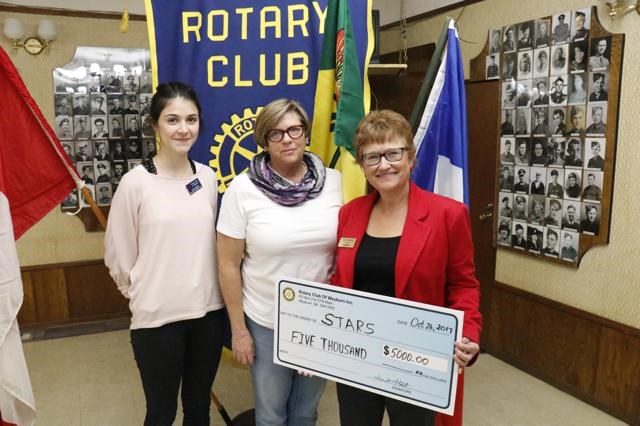STARS Air Ambulance was “born out of necessity” to serve the residents of Saskatchewan, and are continuing to provide emergency medical care in remote rural areas, due in large part to support from partners like the Weyburn Rotary Club, the Rotary members heard at their luncheon meeting on Thursday.
Vanessa Headford of STARS brought an update to the club, and accepted a donation of $5,000 from the Rotary Club raised through the Golf Ball Drop fundraiser held in September as a joint project of the Weyburn and Estevan clubs.
The air ambulance using helicopters began as people were dying needlessly in rural areas, she said, and “the sight of the red helicopter was a beacon of hope.”
In the last five years, STARS has flown 4,200 missions to 500 communities in Saskatchewan, including 90 to Weyburn. In the 2016-17 fiscal year, STARS flew 874 missions, and 13 of them were to Weyburn.
Other communities in the region that have had flights from STARS in the past year include Corinne, Fillmore, Forget, Francis, Sedley, Stoughton and Yellow Grass, which have each had one, and Radville, which has had four.
Some communities like Swift Current and Moose Jaw had significantly more, over 40, and Headford noted that some of these are due to inter-facility transfers of patients into bigger health care facilities in Regina and Saskatoon.
The goal, when a call comes in and it’s determined that emergency services are required, is to have a helicopter lifting off within eight minutes, she said, with either a doctor on board, or in constant communication with the medical crew on board.
The medical crews are always looking for ways to improve, and one recent innovation was to carry blood supplies on board, the first service in Canada to do so, and the second in North America, behind only the Mayo Clinic, said Headford.
Fundraising is a large part of how the service stays in the air, she noted, making events like the Rotary’s Golf Ball Drop very necessary. The STARS service needs about $21 million a year to stay in the air, and of that amount, roughly $10 million is provided by a provincial government grant.
“All dollars raised here in Saskatchewan stays in the province,” she said.
For people who have had life-saving service from STARS, they sometimes urge the patient and their family to meet the crew who helped them once the patient has recovered from his or her injuries, as they have found this is a valuable form of closure for all concerned, said Headford. Some of the patients have gone on to share their stories to help promote the work that STARS does.
Asked about how many personnel it takes to man the Regina base (one of two in Saskatchewan), Headford noted the crews work in two 12-hour shifts, covering the province 24 hours a day, seven days a week. There are 10 pilots based out of Regina, and if more are needed, there are spare pilots that can help based out of Calgary, particularly as Transport Canada rules are very stringent about how many hours a pilot can work.
For the medical crews, there are 11 paramedics and 11 nurses, some of whom work part-time for STARS and are also members of EMS crews.
Also, a fixed-wing craft flies out of Saskatoon, and the helicopters based there are bigger. The Regina-based helicopter carries one patient with medical crew, and can handle two patients if it’s absolutely necessary, where the Saskatoon helicopter can comfortably accommodate two patients. As the Saskatoon base services the northern parts of the province, they may send out the fixed-wing aircraft as it can handle long distances better, said Headford.
“Sometimes when we’re out on a flight, there’s a second call, so it’s nice to have two bases in Saskatchewan,” she added.



